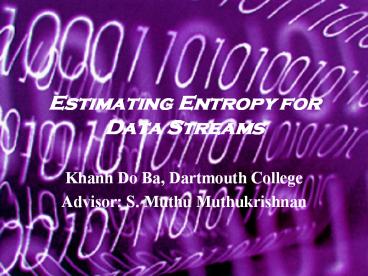Estimating Entropy for Data Streams - PowerPoint PPT Presentation
1 / 10
Title:
Estimating Entropy for Data Streams
Description:
Review of Data Streams Motivation: ... mining email and text message streams, etc. The Mathematical Model Sequence of integers A = a1, ... – PowerPoint PPT presentation
Number of Views:139
Avg rating:3.0/5.0
Title: Estimating Entropy for Data Streams
1
Estimating Entropy for Data Streams
- Khanh Do Ba, Dartmouth College
- Advisor S. Muthu Muthukrishnan
2
Review of Data Streams
- Motivation huge data stream that needs to be
mined for info efficiently. - Applications monitoring IP traffic, mining email
and text message streams, etc.
3
The Mathematical Model
- Sequence of integers A ?a1, , am?, where each
ai ? N 1, , n. - For each v ? N, the frequency mv of v is
occurrences of v in A. - Statistics to be estimated are functions on A,
but usually just on the mvs (e.g. frequency
moments).
4
What is Entropy?
- In physics measure of disorder in a system.
- In math measure of randomness (or uniformity) of
a probability distribution. - Formula
5
Entropy on Data Streams
- For big m, mv/m ? Prv. So formula becomes
- Suffices to compute m (easy) and
6
The Goal
- Approximation algorithm to estimate µ.
- Approximate means to output a number Y such that
PrY µ ?? ?µ ?? e, for any user-specified ?,
e gt 0. - Restrictions o(n), preferably Õ(1), space, and
only 1 pass over data.
7
The Algorithm
- We want Y to have EY µ and very small
variance, so find a computable random variable X
with EX µ and small variance, and compute it
several times. - Y is the median of s2 RVs Yi, each of which is
the mean of s1 RVs Xij X (independently,
identically computed).
8
Computing X
- Choose p ? 1, , m uniformly at random.
- Let r q ? p aq ap ( ? 1).
- X mr log r (r 1) log (r 1).
9
The Analysis
- Easy EY EX µ.
- Hard VarY is very small.
- Turns out s1 O(log n), s2 O(1) works.
- Each X maintained in O(log n log m) space.
- Total O(s1s2(log n log m)) O(log n log m).
10
Future Directions
- Extension to insert/delete streams. Applications
in - DBMSs where massive secondary storage cannot be
scanned quickly enough to answer real-time
queries. - Monitoring open flows through internet routers.
- Lowerbound proof showing algorithm is optimal, or
an improved algorithm.































